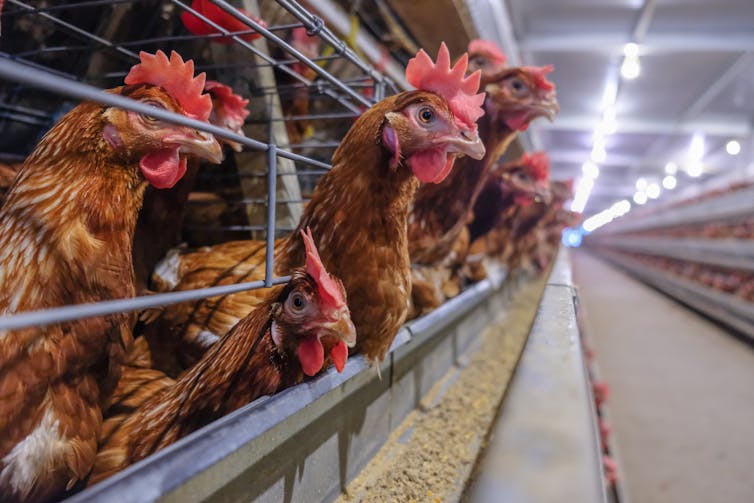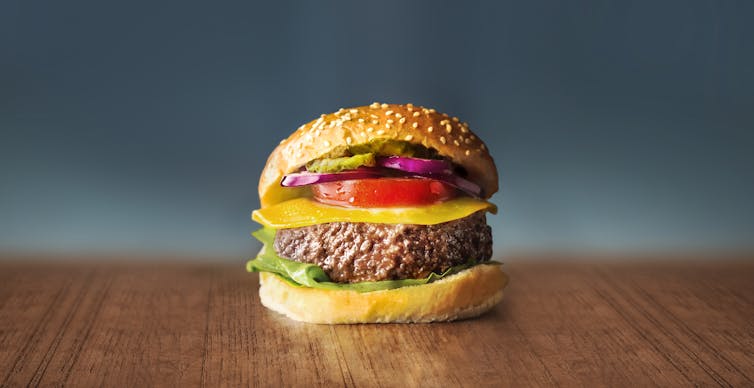The world’s oldest animal welfare charity, Britain’s Royal Society for the Prevention of Cruelty to Animals (RSPCA), is under fire from non-human rights activists Animal Rising.
A food-labelling scheme, RSPCA Assured, marks meat and dairy from farms subject to annual inspections by trained officials. On more than 40 UK farms backed by the label, which denotes a farm inspected to “higher welfare standards”, an Animal Rising investigation has reportedly documented dead and dying animals.
An RSPCA Assured spokesperson is reported to have said an investigation is underway and that welfare breaches on accredited farms are rare.
Read more: RSPCA Assured: animal welfare labels are a hollow money-maker for supermarkets
Ethical meat-eating is apparently more complicated than checking a label in the supermarket. But, you might wonder, what does this have to do with the climate?

This roundup of The Conversation’s climate coverage comes from our weekly climate action newsletter. Every Wednesday, The Conversation’s environment editor writes Imagine, a short email that goes a little deeper into just one climate issue. Join the 30,000+ readers who’ve subscribed.
First, let’s consider what life is like for farmed animals.
Life on a caged planet
More than 100 billion animals are killed for food every year worldwide – hundreds of millions a day. Three-quarters of land livestock (23 billion cows, chickens, turkeys and pigs) and almost all farmed fish will spend their lives prior to slaughter in factory farms according to Hannah Ritchie, a global food system researcher at Oxford University and deputy editor of Our World in Data.
Factory farming involves feeding animals in enclosed spaces with little or no access to the world outside. The collective weight of captive animals reared for food dwarfs that of the planet’s wildlife. That means, through sheer numbers alone, the average experience of life on Earth, at least for vertebrates, is that of a caged animal says Wired writer Andy Greenberg.

The RSPCA estimates that scientists test on 100 million animals (mainly mice and rats) annually – 0.1% of the number slaughtered for food. This tiny cohort is comparatively lucky says Kate Chatfield, deputy director of the Centre for Professional Ethics at the University of Central Lancashire.
Unlike farm animals, lab animal welfare is (at least notionally and in the EU) governed by an ethical code that can be summarised with three Rs: replacement, reduction and refinement. Replace animal testing with other methods where possible, reduce the number of animals used and refine their treatment to eliminate unnecessary suffering.
Read more: Double standards in animal ethics: why is a lab mouse better protected than a cow?
“The three Rs are widely accepted by scientists and the public alike as being a reasonable measure for ethical acceptability,” Chatfield says. So what would happen if we applied this minimum standard to farm animals?
It would mean, Chatfield says, swapping animal products for alternative foods and, where none exist, eating only as many animals as nutritional needs dictate. It just so happens that the Intergovernmental Panel on Climate Change, or IPCC, says something similar about the ideal diet for putting the brakes on global heating.
Four-legged allies
Meat can be a nutritious source of protein and iron, but alternatives abound. Plant-based proteins are about as good for building muscle as their animal-derived equivalents.
Read more: What's the best source of protein for building muscle – meat or plants?
Better yet, growing legumes such as beans, lentils and chickpeas can restore vital nutrients to the soil and slash the need for climate-damaging and water-polluting fertilisers.
Read more: Why the humble legume could be the answer to Europe's fertiliser addiction
There are even alternatives to meat that look and taste like the real thing.
“A whole raft of new technologies is being developed that make a system-wide revolution in food production feasible,” say Chris D Thomas, Jack Hatfield and Katie Noble at the University of York’s Centre for Anthropocene Biodiversity.
The team are referring to cellular agriculture, or “lab-grown food”, that involves culturing meat and dairy products using real animal cells. Research by Thomas showed that this approach could meet rising global demand on 20% of existing farmland – freeing much of the remainder for wildlife habitat that could draw down and lock away planet-warming carbon in the atmosphere.

Read more: New food technologies could release 80% of the world's farmland back to nature
There is a limit to what welfare regulations can achieve for farmed animals according to legal scholar Joe Wills at the University of Leicester.
“When sentient beings are turned into productive units and caught in the maw of economic exploitation, their lives will invariably be characterised by suffering, ill health and denied freedoms,” he says.
Read more: Cow documentary shows the need for fundamental legal rights for animals
And as far as the climate is concerned, there is an opportunity cost attached to keeping animals in cages.
“Recent research has underscored the role that animals in the wild play in keeping climate-warming gases like CO₂ out of the atmosphere,” says Heather Alberro, a lecturer in sustainable development at Nottingham Trent University.
“For instance, wildebeest migrating across Africa’s Serengeti consume large amounts of grassland carbon, which is returned as dung and incorporated into the soil by insects.”
Read more: Grand National protests: Animal Rising campaigners reveal how exploiting animals harms us too
Given the chance to rediscover their wild behaviour, future generations of farmed mammals could contribute to the greatest task of the 21st century: re-stabilising Earth’s climate and biosphere.

